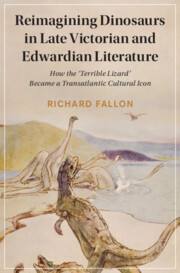 Reimagining Dinosaurs in Late Victorian and Edwardian Literature
Reimagining Dinosaurs in Late Victorian and Edwardian Literature Published online by Cambridge University Press: 28 October 2021
Chapter 3 examines how transatlantic fiction about dinosaurs shaped notions of national potency at a key moment in US and British history. The first half focuses on two American interstellar romances whose violent protagonists vanquish dinosaurs on evolutionarily backward planets. J. J. Astor’s A Journey in Other Worlds (1894) has them conquering Jupiter’s dinosaurs before heading to a Christianised Saturn and learning about the ‘Anglo-Saxon’ race’s spiritual evolution, while in Gustavus Pope’s Journey to Venus (1895) they subdue prehistoric Venus in an unruly pastiche of palaeontological writing. The chapter’s second half provides alternative perspectives from British authors whose narratives, all published in 1899, allude to the ongoing search for giant dinosaurs in the American West as a way of reflecting on nation, empire, and masculinity. Henry Hering’s short story ‘Silas P. Cornu’s Divining-Rod’ ridicules the avarice of the US tycoons who fuelled the dinosaur ‘rush’, while C. J. Cutcliffe Hyne’s The Lost Continent and Frank Savile’s Beyond the Great South Wall have encounters with giant brontosaurs reinvigorating men’s imperialistic masculinity in over-civilised societies.
To save this book to your Kindle, first ensure [email protected] is added to your Approved Personal Document E-mail List under your Personal Document Settings on the Manage Your Content and Devices page of your Amazon account. Then enter the ‘name’ part of your Kindle email address below. Find out more about saving to your Kindle.
Note you can select to save to either the @free.kindle.com or @kindle.com variations. ‘@free.kindle.com’ emails are free but can only be saved to your device when it is connected to wi-fi. ‘@kindle.com’ emails can be delivered even when you are not connected to wi-fi, but note that service fees apply.
Find out more about the Kindle Personal Document Service.
To save content items to your account, please confirm that you agree to abide by our usage policies. If this is the first time you use this feature, you will be asked to authorise Cambridge Core to connect with your account. Find out more about saving content to Dropbox.
To save content items to your account, please confirm that you agree to abide by our usage policies. If this is the first time you use this feature, you will be asked to authorise Cambridge Core to connect with your account. Find out more about saving content to Google Drive.